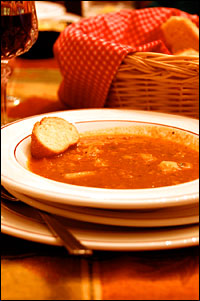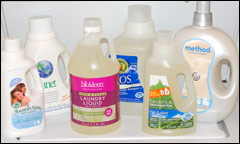Viewed from a distance, the Boston Convention Center looks a bit like a great white whale — an appropriate setting for the annual International Boston Seafood Show.
The building’s vast interior offers great vistas for people-watching, often through huge glass windows. People move through the hallways and aisles in large groups; watching them was a bit like gawking at schools of fish through the glass pane of the giant tank at the Monterey Bay Aquarium.
What sort of species were on display in this human fishbowl? Academic and NGO types darted about here and there, but industry suits dominated. The show is largely — and loudly — about commerce. It’s odd to think of all of these people arranging the fates of so many of the denizens of the ocean when they themselves look like just so many silent, anonymous fish as they hurry from one booth or seminar to the next.
I attended the conference to learn more about the fish industry and to gauge whether true resolve to address the dismal health of the oceans has invaded the halls of seafood commerce. Encouragingly, the captains of the global seafood industry are showing signs of movement toward sustainable fishing practices — and at least the trappings of concern for the ocean as an ecosystem, not just a place for harvesting profits.
All of that was on display in a session called “Sustainability: Where to Get the Answers.” Interestingly, it focused largely on sustainable aquaculture — fish farming. Panelists grappled with the difficult question of how to define sustainability. Who gets to decide what sustainable means, and what factors should go into those decisions?
The panel was moderated by David Beard of The Boston Globe, and panelists included both business and environmentalist types. They discussed where things stand in regard to establishing guidelines for sustainable aquaculture, and noted that there seems to be a consensus forming around how the standards should be created. They seemed to agree that creating effective standards depended on transparency about the process; input from all stakeholders; rigorous, science-based information; emphasis on continuous improvement; and international acceptance.
The panelists noted that aquaculture now provides about 45 percent of the world’s seafood. Given that volume, thorny issues abound: the use of wild fish as feed for farmed fish, feed conversion ratios (i.e., some fish grow well on less feed than others), the treatment of effluent water, energy use, and life-cycle analysis, and overall carbon footprints for aquaculture operations. The panelists also touched on escape of exotic species, exposing wild fish to disease, and the densities at which farmed fish can be raised.
One panelist, Jose Villalon of the World Wildlife Fund, pointed out that mass-scale aquaculture is a relatively new phenomenon. He added that as producers gain more experience with it, they’ll prove to the public that fish farms can be sustainably managed. He noted that, for example, Norwegian fish farmers have been able to dramatically reduce the use of antibiotics, and they have integrated rendering plants into their overall management of the process with the result that they now are able to use their own byproducts. As a result, the tilapia that they raise is a net protein producer.
But are consumers willing to pay up for sustainability? That question led to an interesting discussion. Many of the panelists spoke about the need to educate the public in order to create a demand for sustainable seafood. I was surprised by the idea that industry would have to push consumers toward environmental awareness. As a Grist reader and contributor, I assume that we consumers are always trying to persuade businesses to go green, rather than the other way around. It may well be that in the case of the seafood industry, the suppliers are even more keenly aware than the public of the environmental pressures they themselves face. After all, members of the seafood industry only stand to benefit in the long run if fisheries are well managed — and stand to lose if, for example, fish farms spread disease, or poorly managed fish farms scare the public away from buying fish for health reasons.
They are also well aware that if the public is upset at the environmental cost of poorly managed farms or harvesting practices, that will have an impact on sales.
The question of consumer awareness led one panelist to an interesting anecdote about a fish store that sells only sustainably caught and raised seafood. Here’s the catch: the store hasn’t told its customers yet. “We’re doing this so that the people who work for us can feel good about what they are selling,” the panelist quoted the store manager as saying. “We’re going to tell the customers after we’ve been doing this for a year.”
The cynical side of me wonders whether this also might mean, “We’re going to see how reliably sustainable seafood can be supplied to us before we boast that we offer only sustainable seafood.” In all fairness, that’s something a store legitimately needs to know. Still, I thought it was a telling strategy for a fish retailer.
In short, it seems that for reasons both environmental and market-driven (and these, of course, have a circular relationship), the seafood industry has taken stock of the grave state of the ocean’s health and ability to produce seafood for human consumption. They see that a change is coming and that they must change with it in order to preserve the ocean’s ability to produce fish and shellfish as well as to maintain the trust and confidence of the public.
I left feeling somewhat wary and cynical (it is, after all, my job to be somewhat wary and cynical), but I also felt guardedly optimistic, to borrow a phrase from the intensive-care unit. Come to think of it, given the oceans’ health troubles, the ICU isn’t a bad place to go looking for metaphors.
After the seminar, I wandered down the innumerable aisles, passing booths promoting everything from enormous salmon-gutting machines to the teensiest tastes of tuna, salmon, and crab. By the time I got home, I had developed an intense longing for Manhattan clam chowder. I found my copy of Jasper White’s book Fifty Chowders — here’s his version of this tasty, tomato-based clam soup.
Jasper White’s Manhattan Clam Chowder
From Fifty Chowders, published by Scribner, 2000 (reprinted with permission).
Makes 13 cups. Serves 12 as a first course, 6-8 as a main course.

Photo: alexa627
Clams are perennially listed as one of the “best choices” on the Monterey Bay Aquarium’s seafood choices wallet card, so I feel fine about cooking with them. I love clams in a tomato-based soup, stew, or pasta sauce. Manhattan clam chowder is the perfect dish for a cold winter night if you have some good canned tomatoes on hand. The only change I ever make to this recipe when I cook it is to use a red bell pepper rather than a green one, but that’s just because I am a hater of green peppers (except in the “holy trinity” used in Creole food: green peppers, onions, and celery).
Jasper notes at the beginning of the recipe: “It’s tempting to add the tomatoes early on in this recipe, but don’t do it. They’ll cause the potatoes to form a ‘skin,’ for lack of a better description — that prevents them from releasing their starch. As in most chowders, the light thickening from the potato’s natural starch helps suspend the overall flavor and gives it a lovely texture. This recipe calls for whole peeled tomatoes cut into 1/2-inch dice; if you can find good quality diced canned tomatoes, feel free to substitute them.”
For equipment, you will need an 8-quart pot with a tight-fitting lid (for steaming open the clams), a fine-mesh strainer, a 4-6 quart heavy pot with a lid (for the chowder), a wooden spoon, and a ladle.
4 ounces slab (unsliced) bacon, rind removed and cut into half-inch dice
2 tablespoons olive oil
3 cloves garlic, finely chopped (1 tablespoon)
1 large onion (10 ounces) cut into half-inch dice
2 stalks celery (4 ounces) cut into half-inch dice
1 medium green bell pepper (6 ounces) cut into half-inch dice
2 medium carrots (4 ounces) cut into half-inch dice
2 dried bay leaves
2 teaspoons dried oregano
1/2 teaspoon crushed red pepper flakes
1 1/2 pounds Yukon Gold, Maine, PEI, or other all-purpose potatoes, peeled and cut into half-inch dice
1 cup clam broth, bottled clam juice, fish stock, chicken stock, or water (as a last resort)
1 can (28 ounces) whole peeled tomatoes in juice, cut into half-inch dice
1/4 cup chopped fresh Italian parsley
Freshly ground black pepper
Kosher or sea salt if needed
1. Scrub the clams and rinse clean. Steam them until they open. Strain the broth; you should have 4 cups of broth (and 1 pound of clams). Cover the clams with plastic wrap and keep refrigerated. After they have cooled a bit, dice them into half inch pieces. Cover again and keep refrigerated until ready to use.
2. Heat a 4-6 quart heavy pot over low heat and add the bacon. Once it has rendered a few tablespoons of fat, increase the heat to medium and cook until the bacon is a crisp golden brown. Pour off all but 1 tablespoon of the fat, leaving the bacon in the pot.
3. Add the olive oil and garlic and cook for 30 seconds, then add the onion, celery, bell pepper, carrots, bay leaves, oregano, and crushed red pepper. Saute, stirring occasionally with a wooden spoon, for 10-12 minutes, until the vegetables are softened but not browned.
4. Add the potatoes, the reserved clam broth, and the additional 1 cup of broth or clam juice. The broth should just barely cover the potatoes; if it doesn’t, add enough water to cover. Turn up the heat, bring to a boil, cover, and cook the potatoes vigorously for about 10 minutes, until they are soft on the outside but still firm in the center. If the broth hasn’t thickened lightly, smash a few potatoes against the side of the pot and cook a minute or two longer to release their starch.
5. Add the tomatoes and simmer for another 5 minutes. Remove the pot from the heat, stir in the diced clams and chopped parsley, and season to taste with the black pepper. (It is unlikely that you will need to add any salt; the clams usually provide enough.) If you are not serving the chowder within the hour, let it cool a bit, then refrigerate; cover the chowder after it has chilled completely. Otherwise, let it sit at room temperature for up to an hour, allowing the flavors to meld.
6. When ready to serve, reheat the chowder over low heat, don’t let it boil. Ladle into cups or bowls, making sure the clams, vegetables, and bacon are evenly divided.




